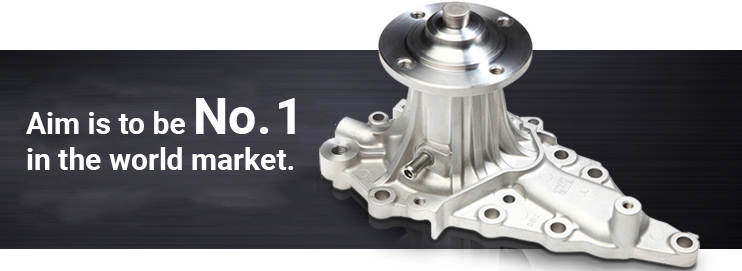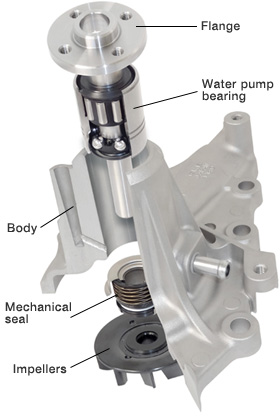Water Pump
Introduction of Waterpump
The water pump is a part of your vehicle with an important role in the engine’s cooling system. The job Of the water pump is to cool down the engine with coolant, which in turn assists in making sure the engine does not overheat. Engine overheating is a very dangerous thing for your car and could lead to eventual engine failure.

It is in your best interest to avoid that at all costs! It is important to understand how the water pump works in the engine’s cooling system so you can be better aware of why your car’s water pump may be failing.
The water pump moves the coolant through the coolant passages that are located in the engine. The coolant helps keep the engine temperature low. The flow of coolant is held back by the thermostat until the coolant reaches the desired temperature, when the thermostat opens up and allows the coolant to flow through the radiator hose into the radiator.
Once in the radiator, the coolant, with the the help of the radiator, the cooling fan, and even the outside air flowing into he grill of your vehicle, dissipates the excess heat. The water pump pushes the coolant back into the engine where the process repeats.

When there is a problem with the flow of operation and your engine starts to get hot, it is time to investigate if your car’s water pump is failing. If the water pump shows signs of weakness or fails completely, coolant will not flow through the cooling system correctly and if coolant does not flow, engine temperatures rise and it begins to overheat.
How to tell if a car’s water pump needs replacement.
The are several safe ways to inspect if your car may need a replacement water pump.
It is in your best interest to avoid that at all costs! It is important to understand how the water pump works in the engine’s cooling system so you can be better aware of why your car’s water pump may be failing.
The water pump moves the coolant through the coolant passages that are located in the engine. The coolant helps keep the engine temperature low. The flow of coolant is held back by the thermostat until the coolant reaches the desired temperature, when the thermostat opens up and allows the coolant to flow through the radiator hose into the radiator.
Once in the radiator, the coolant, with the the help of the radiator, the cooling fan, and even the outside air flowing into he grill of your vehicle, dissipates the excess heat. The water pump pushes the coolant back into the engine where the process repeats.
When there is a problem with the flow of operation and your engine starts to get hot, it is time to investigate if your car’s water pump is failing. If the water pump shows signs of weakness or fails completely, coolant will not flow through the cooling system correctly and if coolant does not flow, engine temperatures rise and it begins to overheat.
How to tell if a car’s water pump needs replacement.
The are several safe ways to inspect if your car may need a replacement water pump.
Step1: |
Check the temperature gauge. Located on your dashboard, the temperature gauge will illuminate if the engine is running hot-You may see a warning light illuminate for low coolant. Here you can notice your temperature gauge rising into the red zone. Pull over and turn off your engine immediately. Warning: If you experience smoke coming from under the hood along with any warning lights, stay clear of the vehicle until it cools off to prevent getting burned by hot coolant. These are all signs of a failing water pump. |
Step2: |
Listen for noises. Listening for strange noises is another way to inspect if your water pump is failing-You will hear strange noises coming from the engine compartment which can sound like a groaning, squealing or squeaking noise. You may notice that these noises increase and decrease as the engine’s RPMs increase and decrease. |
Step3: |
Check the air temperature. Not only does the coolant cool your engine, but it also plays a part in keeping your heater blowing hot.One of the first symptoms you will notice first is that the heater may blow cool air instead of hot air when turned on. If the coolant isn’t circulating or if there is no coolant to circulate, the heater can’t do it’s job Of keeping the inside Of your car warm-This is a sign to pull over safely and turn off your engine. |
Step4: |
Check water pump pulley. With the engine off, open your hood and locate the water pump pulley.With gloves on, grab it and wiggle it back and forth. There should be no movement, if there is, this along with the noise is a good indication you may have a water pump problem. |
Step5: |
Check for leaks. It is possible to see signs of coolant leaking before you experience your vehicle’s engine overheating.you will see drips or puddles Of coolant underneath your car when it is sitting for periods of time, While coolant can be different colors, they all have a sweet smell to them and are easy to identify. Leaks can develop around a gasket or from the weep hole in the water pump, which both acts as a vent and cools the water pump-There are some vehicles that will not allow you to see the water pump without removing the timing cover and this is a lengthy process. If this is the case with your vehicle, it is best to have one of Your Mechanic’s certified mobile mechanics look over your car for proper diagnosing. Note: Leaks at the weep hole or at the water pump gasket are typically caused by contaminated coolant (or dirty coolant). |
Step6: |
Inspect the coolant reservoir. If you think there is a leak, inspect the coolant reservoir. Making sure your water pump is repaired before it causes engine damage is very important. Paying close attention to your vehicle and seeing the signs now can prevent serious inconvenience or permanent damage. |
